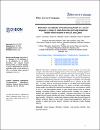Motivation and attitudes toward learning Arabic as a second language: A Study of Arab-American and Arab-expatriate middle school students in the U.S. and Qatar
| Author | Abushihab, Eiman |
| Author | Alkhateeb, Haitham |
| Author | Alkhateeb, Bataul |
| Author | Alkhateeb, Rasha |
| Available date | 2025-11-02T07:06:51Z |
| Publication Date | 2025-10-17 |
| Publication Name | Dibon Journal of Languages (DJL) |
| Identifier | http://dx.doi.org/10.64169/djl.32 |
| Citation | Abushihab, E., Alkhateeb, H., Alkhateeb, R., & Alkhateeb, B. (2025). Motivation and attitudes toward learning Arabic as a second language: A Study of Arab-American and Arab-expatriate middle school students in the U.S. and Qatar. Dibon Journal of Languages, 1(1), 3–23. https://doi.org/10.64169/djl.32 |
| ISSN | 2978-0594 |
| Abstract | Motivation and attitudes toward learning a second language have become key concepts in the field of second language learning. These constructs are widely regarded as essential factors that positively influence and enhance learning in second language contexts. Using the Attitude/Motivation Test Battery (Gardner, 1985), this study assessed the motivation (integrative orientation, instrumental orientation, and parental encouragement) and attitudes toward learning Arabic as a second language in two samples. The first sample comprised 120 middle school Arab-American students in the U.S. (61 boys, 59 girls; mean age = 13.2 years), while the second sample consisted of 113 middle school Arab-expatriate students in Qatar (68 boys, 45 girls; mean age = 13.7 years). To the best of our knowledge, limited research has explored the motivation and attitudes of both Arab-American students in the U.S. and Arab-expatriate students in Qatar toward learning Arabic as a second language. Descriptive statistics, Pearson product-moment correlation, and analysis of variance were applied to examine the students’ motivation and attitudes. The findings revealed that both groups exhibited high levels of motivation and positive attitudes toward learning Arabic. Furthermore, a positive and moderate correlation was observed between the different constructs. Based on these results, several recommendations for teachers are provided to support and enhance students’ motivation and attitudes in Arabic language learning. |
| Language | en |
| Publisher | Dibon Publishing House |
| Subject | Arabic language Motivation Attitudes Arab-American Students Arab-Expatriate Students |
| Type | Article |
| Pagination | 3–23 |
| Issue Number | 1 |
| Volume Number | 1 |
Files in this item
This item appears in the following Collection(s)
-
Arabic for Non Native Speakers [16 items ]


